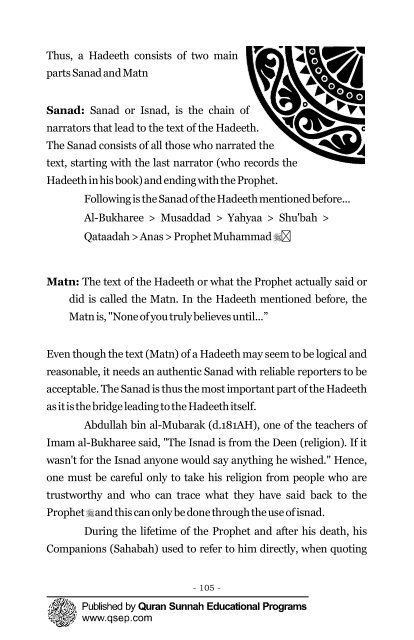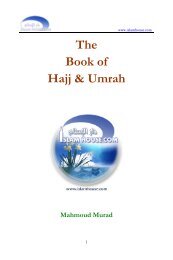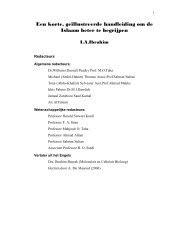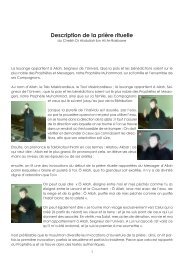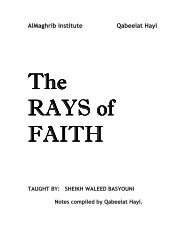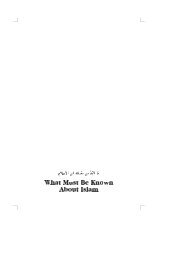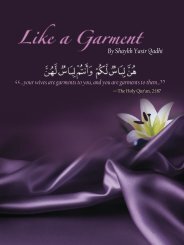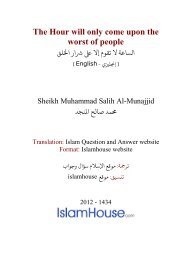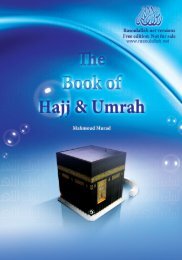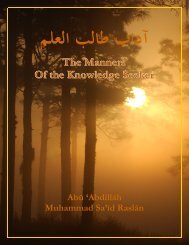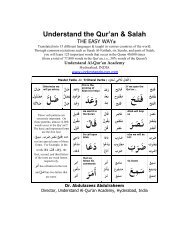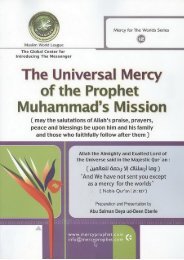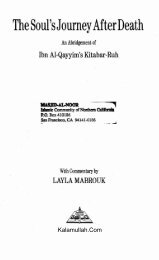A critical analysis of the Modernists and the Hadeeth ... - Islam House
A critical analysis of the Modernists and the Hadeeth ... - Islam House
A critical analysis of the Modernists and the Hadeeth ... - Islam House
Create successful ePaper yourself
Turn your PDF publications into a flip-book with our unique Google optimized e-Paper software.
Thus, a <strong>Hadeeth</strong> consists <strong>of</strong> two main<br />
parts Sanad <strong>and</strong> Matn<br />
Sanad:<br />
Sanad or Isnad, is <strong>the</strong> chain <strong>of</strong><br />
narrators that lead to <strong>the</strong> text <strong>of</strong> <strong>the</strong> <strong>Hadeeth</strong>.<br />
The Sanad consists <strong>of</strong> all those who narrated <strong>the</strong><br />
text, starting with <strong>the</strong> last narrator (who records <strong>the</strong><br />
<strong>Hadeeth</strong> in his book) <strong>and</strong> ending with <strong>the</strong> Prophet.<br />
Following is <strong>the</strong> Sanad <strong>of</strong> <strong>the</strong> <strong>Hadeeth</strong> mentioned before...<br />
Al-Bukharee > Musaddad > Yahyaa > Shu'bah ><br />
Qataadah > Anas > Prophet Muhammad �.<br />
Matn: The text <strong>of</strong> <strong>the</strong> <strong>Hadeeth</strong> or what <strong>the</strong> Prophet actually said or<br />
did is called <strong>the</strong> Matn. In <strong>the</strong> <strong>Hadeeth</strong> mentioned before, <strong>the</strong><br />
Matn is, "None <strong>of</strong> you truly believes until...”<br />
Even though <strong>the</strong> text (Matn) <strong>of</strong> a <strong>Hadeeth</strong> may seem to be logical <strong>and</strong><br />
reasonable, it needs an au<strong>the</strong>ntic Sanad with reliable reporters to be<br />
acceptable. The Sanad is thus <strong>the</strong> most important part <strong>of</strong> <strong>the</strong> <strong>Hadeeth</strong><br />
as it is <strong>the</strong> bridge leading to <strong>the</strong> <strong>Hadeeth</strong> itself.<br />
Abdullah bin al-Mubarak (d.181AH), one <strong>of</strong> <strong>the</strong> teachers <strong>of</strong><br />
Imam al-Bukharee said, "The Isnad is from <strong>the</strong> Deen (religion). If it<br />
wasn't for <strong>the</strong> Isnad anyone would say anything he wished." Hence,<br />
one must be careful only to take his religion from people who are<br />
trustworthy <strong>and</strong> who can trace what <strong>the</strong>y have said back to <strong>the</strong><br />
Prophet �<strong>and</strong><br />
this can only be done through <strong>the</strong> use <strong>of</strong> isnad.<br />
During <strong>the</strong> lifetime <strong>of</strong> <strong>the</strong> Prophet <strong>and</strong> after his death, his<br />
Companions (Sahabah) used to refer to him directly, when quoting<br />
- 105 -


